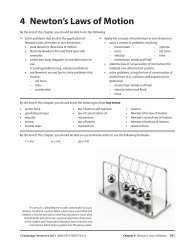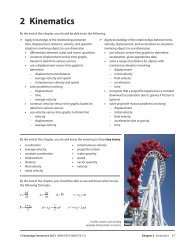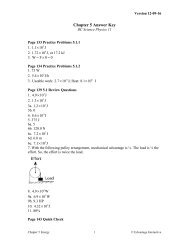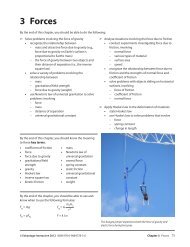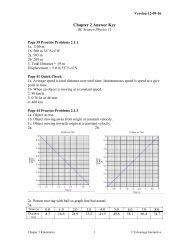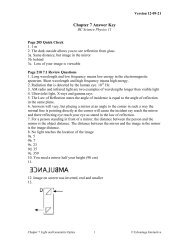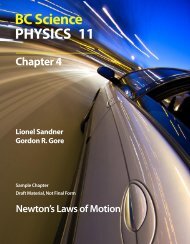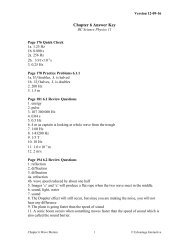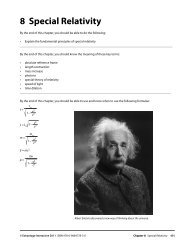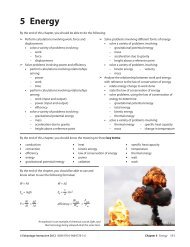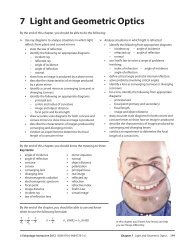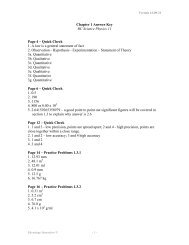BCPhysics 11-6.indd - BC Science Physics 11
BCPhysics 11-6.indd - BC Science Physics 11
BCPhysics 11-6.indd - BC Science Physics 11
You also want an ePaper? Increase the reach of your titles
YUMPU automatically turns print PDFs into web optimized ePapers that Google loves.
6 Wave Motion<br />
By the end of this chapter, you should be able to do the following:<br />
➢ Analyse the behaviour of light and other waves under various conditions, with reference to the properties of waves<br />
and using the universal wave equation<br />
• Describe the properties associated with waves, including amplitude, frequency, period, wavelength, phase,<br />
speed, and types of waves<br />
• Use the universal wave equation to solve problems involving speed, frequency (period), and wavelength<br />
• Describe and give examples of the following wave phenomena and the conditions that produce them:<br />
– reflection<br />
– refraction<br />
– diffraction<br />
– interference (superposition principle)<br />
– Doppler shift<br />
By the end of this chapter, you should know the meaning of these key terms:<br />
• amplitude • period<br />
• constructive interference • periodic wave<br />
• crests • pulse<br />
• destructive interference • reflection<br />
• diffraction • refraction<br />
• Doppler effect • sonic boom<br />
• frequency • sound barrier<br />
• hertz • transverse wave<br />
• longitudinal wave • troughs<br />
• nodal lines • wavelength<br />
By the end of this chapter, you should<br />
be able to use and know when to use<br />
the following formulae:<br />
T = 1<br />
f<br />
v = f<br />
A tiny drop creates a pattern of circular waves.<br />
© Edvantage Interactive 2012 ISBN 978-0-9864778-3-6 Chapter 6 Wave Motion 173
6.1 Wave Properties<br />
Warm Up<br />
Fill a wine glass with water. Dip your finger in the water and run your wet<br />
finger around the edge of the glass until the glass starts to emit a highpitched<br />
sound. While you are doing this, watch the surface of the water<br />
near where your finger is making the glass vibrate. Try the same activity<br />
with varying depths of water.<br />
1. What effect does adding water to the glass have on the pitch of the<br />
sound you hear?<br />
___________________________________________________________<br />
2. Will the glass vibrate when it is empty? Why or why not?<br />
_________________________________________________________________________________________<br />
_________________________________________________________________________________________<br />
Good Vibrations<br />
There are many kinds of waves in nature. You have heard of light waves, sound waves,<br />
radio waves, earthquake waves, water waves, shock waves, brain waves and the familiar<br />
wave created by a cheering crowd at a sports event. Wave motion is an important<br />
phenomenon because it is so common and it is one of the major ways in which energy<br />
can be transmitted from one place to another.<br />
There are two basic kinds of waves. First, there is the pulse, which is a nonrepeating<br />
wave. A single disturbance sends a pulse from the source outward, but there<br />
is no repetition of the event. For example, you may give a garden hose a quick “yank” to<br />
one side, causing a pulse to travel the length of the hose.<br />
Second, there is the periodic wave. Periodic waves are probably more familiar<br />
to you. You have watched water waves moving across a pond. The waves arrive at the<br />
shore of the pond at regularly repeated time intervals. Periodic means recurring at regular<br />
intervals. Water waves are caused by a disturbance of the water somewhere in the pond.<br />
Whether the wave is a pulse or a periodic wave, a disturbance is spread by the wave,<br />
usually through a material substance. An exception is the medium for electromagnetic<br />
radiation (light, radio, X-rays, ultraviolet, infrared, gamma radiation, etc.). The medium for<br />
electromagnetic radiation is electric and magnetic fields created by charged particles.<br />
To have a regularly repeating wave, there must be regularly repeating vibrations.<br />
For example, the regularly repeating sound waves from a tuning fork are caused by the<br />
vibrations of the two tines of the fork disturbing the air. Vibrating electrons disturb the<br />
electric field around them to create the microwaves that cook your supper or measure the<br />
speed of your car in a radar trap.<br />
174 Chapter 6 Wave Motion © Edvantage Interactive 2012 ISBN 978-0-9864778-3-6
Describing Waves<br />
Wavelength (λ)<br />
Figure 6.1.1 depicts waves emanating from a vibrating source. They could be water<br />
waves. The highest points on the waves are called crests and the lowest points are called<br />
troughs. The distance between successive crests or between successive troughs is called<br />
the wavelength (λ) of the wave. The symbol λ is the Greek letter lambda. The amplitude<br />
or height of the wave is measured from its displacement from the horizontal line in the<br />
diagram to the crest or trough. The amplitude is shown on the diagram.<br />
Wavelengths may be measured in metres, in the case of water waves, or in<br />
nanometres (1 nm = 10 –9 ), in the case of visible light. Microwaves may be measured<br />
in centimetres, while the waves produced by AC power lines may be kilometres long.<br />
Wavelengths of audible sounds range from millimetres up to metres.<br />
����������<br />
�<br />
����� ����� �����<br />
������ ������<br />
������<br />
�<br />
����������<br />
���������<br />
Figure 6.1.1 Terms used for describing waves<br />
Frequency (f)<br />
Another important aspect of waves is their frequency. The frequency of the waves tells<br />
you how often or frequently they and their source vibrate. If you are listening to a tuning<br />
fork, sound waves reach your ear with the same frequency as the vibrating fork. For<br />
example, the fork’s tines vibrate back and forth 256 times in 1 s if the frequency of the fork<br />
is 256 vibrations per second. Frequency is measured in a unit called the hertz (Hz). The<br />
unit is named after Heinrich Hertz (1857–1894), who was the first scientist to detect radio<br />
waves. One hertz is one vibration per second: 1 Hz = 1 s –1 .<br />
A pendulum 24.8 cm long has a frequency of 1 Hz. Electrons vibrating to and fro<br />
in an alternating current circuit have a frequency of 60 Hz. Radio waves may be several<br />
kilohertz (kHz), where 1 kHz = 1 000 Hz, or they may be in the megahertz (MHz) range,<br />
where 1 MHz is equal to 1 000 000 Hz.<br />
Period (T)<br />
Related to the frequency of a vibration is the period of the vibration. The period is the<br />
time interval between vibrations. For example, if the period of a vibration is 1/2 s, then<br />
the frequency must be 2 s –1 or 2 Hz. Consider a pendulum with a length of 24.8 cm. It<br />
will have a frequency of 1 Hz and a period of 1 s. A pendulum 99.2 cm long will have a<br />
frequency of 1/2 Hz and a period of 2 s. A pendulum 223 cm long will have a frequency<br />
of 1/3 Hz and a period of 3 s. As you can see, frequency and period are reciprocals of each<br />
other.<br />
frequency =<br />
1<br />
period<br />
© Edvantage Interactive 2012 ISBN 978-0-9864778-3-6 Chapter 6 Wave Motion 175<br />
f =<br />
1<br />
T<br />
or T =<br />
1<br />
f
Quick Check<br />
1. A dog’s tail wags 50.0 times in 40.0 s.<br />
(a) What is the frequency of the tail?<br />
_____________________________________________________________________________<br />
(b) What is the period of vibration of the tail?<br />
_____________________________________________________________________________<br />
2. A certain tuning fork makes 7680 vibrations in 30 s.<br />
(a) What is the frequency of the tuning fork?<br />
_____________________________________________________________________________<br />
(b) What is the period of vibration of the tuning fork?<br />
_____________________________________________________________________________<br />
3. Tarzan is swinging back and forth on a vine. If each complete swing takes 4.0 s, what is the frequency of the<br />
swings?<br />
_____________________________________________________________________________<br />
Transverse and<br />
Longitudinal Waves<br />
Figure 6.1.2 illustrates two ways to send a pulse through a long length of spring or a<br />
long Slinky. In method (a), the spring is pulled sideways, so that the disturbance is at<br />
right angles to the direction that the pulse will travel. This produces a transverse wave.<br />
In method (b), several turns of the spring are compressed and let go. The disturbance is<br />
in the same direction as the direction the pulse will travel. This produces a longitudinal<br />
wave. Transverse means across and longitudinal means lengthwise.<br />
���<br />
���<br />
Figure 6.1.2 (a) A transverse wave; (b) A longitudinal wave<br />
176 Chapter 6 Wave Motion © Edvantage Interactive 2012 ISBN 978-0-9864778-3-6
Wave Re�ection and<br />
Refraction<br />
The Wave Equation<br />
When a wave encounters a boundary like a shoreline, wall or another medium, several<br />
things can happen. The two most common things are the wave will reflect or refract.<br />
Reflection occurs when a wave hits an object or another boundary and the wave is<br />
reflected back. If you attach or hold one end of a spring and send a wave down the<br />
spring, you will see it reflect off the end. Usually not all the wave is reflected back as some<br />
can be absorbed or refracted. Refraction is a bending of the wave and occurs when the<br />
wave hits an object at an angle or the wave enters a new medium. Refraction results from<br />
the change in the waves speed. The changing speed causes the wave to bend.<br />
The wave shown in Figure 6.1.3 is moving through water in a wave tank. The waves in<br />
the wave tank are produced by a wave generator, which vibrates up and down with a<br />
frequency ƒ and a period T where T = 1/f.<br />
�<br />
����������<br />
Figure 6.1.3 A wave in a wave tank<br />
What is the speed of the wave? If you could see the wave tank, you could watch a<br />
wave travel its own length, or wavelength λ, and time exactly how long the wave takes<br />
to travel its own length. Since the waves are generated once every T seconds by the<br />
generator, then this T should be the period of the waves. To calculate the speed v of the<br />
waves, all you have to do is divide the wavelength by the period of the wave.<br />
v = λ/ T<br />
Since T = 1/ f or f = 1/T<br />
v = fλ<br />
This relationship is a very important one, because it is true for any kind of wave. This<br />
includes sound waves, earthquake waves, waves in the strings of musical instruments or<br />
any kind of electromagnetic wave (light, infrared, radio, X-radiation, ultraviolet, gamma<br />
radiation, etc.)! In words, the wave equation says<br />
wave speed = wavelength × frequency<br />
Sample Problem 6.1.1 — Calculating Wave Speed<br />
What is the speed of a sound wave if its frequency is 256 Hz and its wavelength is 1.29 m?<br />
What to Think About<br />
1. Determine what you need to find.<br />
2. Select appropriate formula.<br />
3. Find the speed of sound<br />
How to Do It<br />
speed of sound<br />
v = λƒ<br />
v = (1.29 m)(256 s –1 ) = 330 m/s<br />
© Edvantage Interactive 2012 ISBN 978-0-9864778-3-6 Chapter 6 Wave Motion 177
Practice Problems 6.1.1 — Calculating Wave Speed<br />
1. If waves maintain a constant speed, what will happen to their wavelength if the frequency of the waves is<br />
(a) doubled?<br />
(b) halved?<br />
2. What is the frequency of a sound wave if its speed is 340 m/s and its wavelength is 1.70 m?<br />
3. Waves of frequency 2.0 Hz are generated at the end of a long steel spring. What is their wavelength if the<br />
waves travel along the spring with a speed of 3.0 m/s?<br />
The Wave Tank as a<br />
Wave Model<br />
��������������<br />
The wave tank is an ingenious device that permits us to study the behaviour of waves<br />
using a water wave model. If a series of waves is generated by moving a piece of wood<br />
dowelling back and forth in a regularly repeating motion, the waves will look like the<br />
ones in Figure 6.1.4 if seen from the side. The actual water<br />
� �<br />
������������<br />
������������<br />
����������������<br />
������������������<br />
����������������<br />
����������������<br />
���������������<br />
�����<br />
�����<br />
Figure 6.1.4 Using a light source to observe water waves in a<br />
wave tank<br />
waves are transverse in nature.<br />
If light from a point source is allowed to pass<br />
through the waves and fall on a large sheet of white<br />
paper, the light passing through the waves will form<br />
bright lines on the paper underneath the crests of the<br />
waves. In Figure 6.1.4, the point source of light is the end<br />
of the filament of a straight-filament, clear light bulb.<br />
The crests act as convex lenses and make the light from<br />
the source converge or come together. The troughs, on<br />
the other hand, act as concave lenses and make the light<br />
from the source diverge or spread out. The image you<br />
see on the white screen consists of a series of bright lines<br />
with dark spaces between successive bright lines. The<br />
bright lines represent crests and the dark areas represent<br />
troughs. The waves you see on the screen are longitudinal<br />
waves, whereas the actual water waves were transverse.<br />
178 Chapter 6 Wave Motion © Edvantage Interactive 2012 ISBN 978-0-9864778-3-6
Investigation 6-1A Observing Transverse and Longitudinal Waves<br />
Purpose<br />
To observe pulses travelling in springs of different diameters<br />
Procedure<br />
1. With your partner’s help, stretch a long spring about 2.5 cm in diameter to a length of 9 or 10 m. Hold on firmly<br />
as both you and the spring can be damaged if it is let go carelessly.<br />
2. Create a transverse pulse by pulling a section of the spring to one side and letting it go suddenly. Observe the<br />
motion of the pulse and its reflection from your partner’s hand.<br />
3. Try increasing the amplitude of the pulse. Does this affect the speed of the wave through the spring?<br />
4. Try tightening the spring. How does increasing the tension affect the speed of the pulse?<br />
5. Observe the pulse as it reflects. Does a crest reflect as a crest or as a trough?<br />
6. Have your partner create a pulse simultaneously with yours. Do the two pulses affect each other as they pass<br />
through each other?<br />
7. Repeat Procedure steps 1 to 6 using a long Slinky, which is a spring with a much larger diameter.<br />
8. Try sending a longitudinal pulse through each spring. To do this, bunch up a dozen or so turns of the spring,<br />
then let the compressed section go. Do longitudinal waves reflect at your partner’s hand?<br />
Concluding Questions<br />
1. In which spring did the transverse waves travel faster — the small diameter spring or the Slinky?<br />
2. In which spring did the longitudinal waves travel faster?<br />
3. Does the amplitude of the waves affect their speed through the spring?<br />
4. Does spring tension affect wave speed? Explain.<br />
5. When a wave travels through the medium, like the spring, does the medium travel or just the disturbance in the<br />
medium?<br />
6. When a wave reflects from a fixed end of the medium, does a crest reflect as a crest or is it reflected as a trough?<br />
In other words, is the wave inverted?<br />
© Edvantage Interactive 2012 ISBN 978-0-9864778-3-6 Chapter 6 Wave Motion 179
Investigation 6-1B Wavelength, Frequency, and Speed of Water Waves<br />
Purpose<br />
To investigate the relationship among wavelength, frequency and wave speed<br />
������<br />
���������������<br />
����������<br />
��������������<br />
Figure 6.1.5 Using different types of sources to observe water waves in a wave tank<br />
Procedure<br />
1. Fill your wave tank with water to a depth of approximately 2 cm. If your tank requires them, make sure the<br />
screen dampers are in place.<br />
2. To generate a circular wave, touch the surface of the water at the centre of the tank with the tip of your finger.<br />
Is there any evidence that the wave speeds up or slows down as it travels from the centre of the tank to its<br />
perimeter?<br />
3. Imagine a single point on one of the crests that you see moving out from the centre of the tank. What path<br />
would this point on the crest take?<br />
4. Set up your wave generator so that it generates circular waves at regular intervals. Start with a low frequency.<br />
Note the wavelength of the circular waves. This is the distance between successive crests. Increase the<br />
frequency of the wave generator and observe how the wavelength changes.<br />
5. Set up your wave generator so that it produces straight waves instead of circular waves. Try different<br />
frequencies to see the effect of frequency on wavelength.<br />
Concluding Questions<br />
1. Does a circular wave travel out at the same speed in all directions? How do you know this?<br />
2. Describe what happens to the wavelength of a water wave when the frequency of the wave increases.<br />
180 Chapter 6 Wave Motion © Edvantage Interactive 2012 ISBN 978-0-9864778-3-6
6.1 Review Questions<br />
1. What is the source of all wave motion?<br />
2. What kind of wave has no amplitude and no<br />
frequency?<br />
3. How vibrations per second are there from a radio<br />
signal from 107.3 MHz?<br />
4. What is the period of a wave that has a frequency of<br />
25 Hz?<br />
5. What is the frequency of a wave that has the period<br />
of 2.0 s?<br />
6. When a salmon fishing boat captain describes<br />
waves as being 8 m high, what is the approximate<br />
amplitude of these waves? Explain your answer.<br />
7. What is the frequency of the second hand on a<br />
clock?<br />
8. What is the frequency of the hour hand on a clock?<br />
© Edvantage Interactive 2012 ISBN 978-0-9864778-3-6 Chapter 6 Wave Motion 181
9. If the frequency of a sound is tripled, what will<br />
happen to the period of the sound waves?<br />
10. A student measures the speed of water waves in her<br />
tank to be 25 cm/s. If the wavelength is 2.5 cm, what<br />
is the frequency of the waves?<br />
<strong>11</strong>. Some microwaves have a frequency of 3.0 × 10 10<br />
Hz. How long is a microwave of this frequency?<br />
(Microwave radiation travels at the speed of light.)<br />
12. While fishing, a girl notices the wave crests passing<br />
her bob once every 6 s. She thinks the distance<br />
between crests is about 12 m. What is the speed of<br />
the water waves?<br />
182 Chapter 6 Wave Motion © Edvantage Interactive 2012 ISBN 978-0-9864778-3-6
6.2 Wave Phenomena<br />
Warm Up<br />
You and a friend both throw rocks into a lake. The rocks enter the water 1.0 m apart. If you were looking down<br />
from above, draw what you think the wave pattern for each of the rocks will look like. Place the letter X at the<br />
point or points where the waves would be the highest.<br />
Properties of Waves<br />
Constructive<br />
and Destructive<br />
Interference<br />
�������������������<br />
���������������������<br />
Figure 6.2.1 Constructive interference<br />
��������������������������������������������������������<br />
�������������������<br />
Figure 6.2.2 ���������������������<br />
Destructive interference<br />
��������������������������������������������������������<br />
You already know several properties of waves. Waves can be reflected and refracted. All<br />
waves conform to the wave equation. There are other important properties of waves, such<br />
as constructive and destructive interference, that lead to interesting natural phenomena.<br />
Figure 6.2.1 shows waves coming from two different sources — A and B. What happens<br />
if the two sets of waves arrive simultaneously at the same place? The result is shown in<br />
�������������������<br />
the third diagram. The amplitudes of the two sets of waves are additive. Since the waves<br />
from source A are in phase with the waves from source B, the resultant waves have twice<br />
the amplitude of the individual waves from A or B. This is an example of what is called<br />
constructive interference. Notice that crests are twice as high ���������������������<br />
and troughs are twice as<br />
�������������������<br />
deep in the combined waves.<br />
���������������������<br />
��������������������������������������������������������<br />
��������������������������������������������������������<br />
�������������������<br />
In Figure 6.2.2, the waves from source A are exactly out of phase with the waves<br />
from source B. A crest from source A arrives simultaneously with a trough from source<br />
B. The two sets of waves �������������������<br />
exactly cancel each other. This is an example ���������������������<br />
of destructive<br />
interference.<br />
���������������������<br />
��������������������������������������������������������<br />
��������������<br />
��������������������������������������������������������<br />
��������������<br />
© Edvantage Interactive �������������� 2012 ISBN 978-0-9864778-3-6 Chapter 6 Wave Motion 183
Young’s Experiment<br />
Interference Pattern<br />
Interference of waves occurs with all sorts of waves. You may have seen interference<br />
of water waves in the wave tank. You can hear interference of sound waves if you simply<br />
listen to a tuning fork as you rotate it slowly near your ear. Each tine of the fork produces<br />
a set of sound waves. Listen for constructive interference. It’s the extra loud sound.<br />
Destructive interference is the minimum sound you hear as you slowly rotate the tuning<br />
fork.<br />
The interference property of waves was first used to measure the wavelength of light by<br />
the English scientist Thomas Young (1773–1829). Young’s interference experiment, done<br />
in 1801, has great historical importance because it seemed to suggest very strongly that<br />
light is a wave phenomenon.<br />
Figure 6.2.3 illustrates how Young’s experiment was done. A single slit was<br />
illuminated by a source of light of one colour (wavelength). Circular waves spread out<br />
from the single slit. When the wave front hit the double slit, each of these two slits acted<br />
as a new source of circular waves that travelled toward a vertical screen. On the screen a<br />
series of bright and dark bands of light appeared. A sheet of photographic film could be<br />
substituted for the screen.<br />
Young’s interference experiment can be illustrated very easily now using a<br />
classroom laser. The laser automatically produces one single wavelength, and the<br />
interference pattern is bright enough to see even in a well-lit room.<br />
������<br />
�<br />
�<br />
�����������<br />
Figure 6.2.3 Young’s experiment<br />
184 Chapter 6 Wave Motion © Edvantage Interactive 2012 ISBN 978-0-9864778-3-6<br />
�<br />
�<br />
�<br />
������<br />
����<br />
������<br />
����<br />
������<br />
In Figure 6.2.3, the concentric circles represent successive peaks of light waves coming<br />
from the slits. Troughs are midway between the peaks, of course. They are not shown in<br />
the diagram because it becomes too cluttered with detail.<br />
On the screen on the right, you would see a series of bright and dark bands, which<br />
is an interference pattern. At the bright bands (C, D, and E), crests from the two slits arrive<br />
simultaneously, as do troughs. There is constructive interference of the two sets of waves.<br />
Notice that waves arriving at D have travelled the same distance from their slits.
Figure 6.2.4 Using the<br />
interference pattern to<br />
calculate the wavelength of<br />
light<br />
Waves arriving at C or at E have travelled distances that differ by exactly one<br />
wavelength (λ). Again, the peaks arrive simultaneously and the troughs arrive<br />
simultaneously, and there is constructive interference causing the bright bands at<br />
C and E.<br />
Figure 6.2.3 is simplified. There will be other bright bands farther out on both sides<br />
of the central bright band. These bright bands will occur wherever the difference in<br />
distance travelled from slits A and B is an integral number of wavelengths.<br />
At the dark bands, called nodal lines, waves from the two sources arrive out of<br />
phase. That is, when a crest from slit A is arriving, a trough from slit B is also arriving.<br />
The crest cancels the trough. This is destructive interference. The amplitudes of the two<br />
arriving waves cancel each other and you see no light.<br />
Figure 6.2.4 shows the geometry of the situation, and how you can use the<br />
interference pattern to calculate the wavelength of the light. For simplicity, the first bright<br />
band adjacent to the central bright band is used.<br />
CA is the distance from the screen to source (slit) A. CB is the distance from the<br />
screen to the second slit B. The difference in these two distances is BF, which is one<br />
wavelength.<br />
BF = CB – CA = λ<br />
�<br />
�<br />
�<br />
�<br />
�<br />
�<br />
�<br />
In the diagram, GD is the central maximum. A bright band appears on the screen at<br />
D. A dashed line, CG, joins the midpoint of the two slits with the bright band at C. You will<br />
note that there are similar triangles on this diagram.<br />
Since ∆BFA ~ ∆CDG, therefore BF<br />
CD<br />
= AB<br />
CG<br />
This means that the wavelength BF can be calculated as follows:<br />
BF = (CD) AB<br />
CG<br />
or λ = (CD) AB<br />
CG<br />
where CD is the distance on the screen between the central bright band and the first<br />
bright band to either side of it; AB is the distance between the two slits or sources; and CG<br />
is the distance from the midpoint of the two slits to the first bright band on the screen.<br />
© Edvantage Interactive 2012 ISBN 978-0-9864778-3-6 Chapter 6 Wave Motion 185<br />
�<br />
�
Diffraction<br />
For the second bright band, BF = 2λ ; for the third bright band, BF = 3λ; and for the<br />
nth bright band, BF = nλ.<br />
In general, for the nth bright band:<br />
nλ = (CD) AB<br />
CG and<br />
λ = (CD)(AB)<br />
n(CG)<br />
This relationship can be used to calculate the wavelength of light from an<br />
interference pattern. It can also be used to calculate the wavelength of water waves in a<br />
wave tank.<br />
If you are familiar with simple trigonometry and you study Figure 6.2.4, you will<br />
notice that the ratio of side CD to side CG of triangle CDE is equal to the sine of angle G<br />
(which is called θ on the diagram). You will see that the formula for the wavelength can,<br />
therefore, be written<br />
λ = AB<br />
n<br />
186 Chapter 6 Wave Motion © Edvantage Interactive 2012 ISBN 978-0-9864778-3-6<br />
sin θ<br />
where θ is the angle between the line GD (central bright band) and the line GC<br />
(nth bright band), and n is the number of the bright band. If the symbol d is used for the<br />
distance between slits (AB), the formula can be written<br />
nλ = dsinθ<br />
You hear someone talking from around a corner. Light leaks through a crack in a<br />
closed door. These are both examples of another property of waves called diffraction.<br />
Diffraction is when a wave spreads out as it passes through narrow openings, around<br />
corners or small obstacles.<br />
You have probably seen examples of diffraction many times, perhaps without<br />
knowing what it was. If you look out at streetlights through a window screen or a fine<br />
mesh curtain, the starburst effect you see is due to diffraction of light waves as they pass<br />
by the screen. Diffraction is often used in television programs to obtain starburst effects<br />
in musical productions. Diffraction is commonplace with sound. Figure 6.2.5 shows the<br />
diffraction of red laser light around a razor blade.<br />
Figure 6.2.5 Using the interference pattern to calculate the wavelength of light
The Doppler Effect<br />
The Sound Barrier<br />
When a fast car or motorbike approaches you, the pitch of its sound rises. As the vehicle<br />
goes by, the pitch lowers. The effect is quite noticeable if you watch a high-speed<br />
automobile race on television. What causes this change in pitch? Austrian physicist<br />
C. J. Doppler (1803–1853) was the first to explain the effect in terms of waves, and<br />
therefore the effect is called the Doppler effect.<br />
Figure 6.2.6 illustrates sound waves coming from a moving source. The vehicle is<br />
moving to the left. Sound waves coming from the vehicle are bunched in front of the<br />
vehicle, which tends to catch up with its own sound. (This diagram exaggerates the<br />
effect.) The wave fronts or compressions are closer together in front of the vehicle and<br />
farther apart behind the vehicle.<br />
The observer at A hears a higher pitch than normal, since more compressions and<br />
rarefactions pass his ear per second than pass the observer at B. Observer B hears the<br />
normal pitch of the vehicle’s sound. Behind the vehicle, compressions are spaced out,<br />
since the vehicle is travelling away from the sound it sends in that direction. The observer<br />
at C hears a lower pitch than normal. Fewer compressions and rarefactions pass his ear<br />
per second than if he was at A or B. As the vehicle passes observer A, he will hear the<br />
pitch go from high to normal to low in a very short time interval. He will hear the Doppler<br />
effect.<br />
�<br />
�<br />
Figure 6.2.6 The wave fronts are closer together at the front of the moving vehicle as it moves forward and<br />
more spread out behind.<br />
An extreme case of the Doppler effect occurs when an aircraft or bullet travels at<br />
the same speed as the sound it is producing. At the leading edges of the aircraft,<br />
the compressions it creates tend to bunch up and superimpose on each other<br />
(Figure 6.2.7(a)). This creates a wall or barrier of compressed air called the sound barrier.<br />
Great thrust is needed from the plane’s engines to enable the plane to penetrate the<br />
sound barrier. Once through the barrier, the plane experiences much less resistance to its<br />
movement through the air. The plane, once through the sound barrier, is then supersonic.<br />
Its speed is now greater than Mach 1!<br />
© Edvantage Interactive 2012 ISBN 978-0-9864778-3-6 Chapter 6 Wave Motion 187<br />
�
�����<br />
�������<br />
(a) (b)<br />
Figure 6.2.7 (a) The airplane travelling at the speed of sound creates a wall of compressed called the sound barrier; (b) An airplane travelling<br />
faster than the speed of sound creates a shock wave that you hear as a sonic boom.<br />
Shock Waves and the Sonic Boom<br />
If a plane travels faster than sound, it gets ahead of the compressions and rarefactions<br />
it produces. In two dimensions (Figure 6.2.7(b)), overlapping circular waves form a Vshaped<br />
bow wave, somewhat like what you see from the air looking down at a speedboat<br />
travelling through still water. In three dimensions, there is a cone of compressed air<br />
trailing the aircraft. This cone is called a shock wave. When the shock wave passes you,<br />
you hear a loud, sharp crack called the sonic boom. Aircraft are not the only producers of<br />
sonic booms. Cracking whips and rifle bullets causes miniature sonic booms!<br />
188 Chapter 6 Wave Motion © Edvantage Interactive 2012 ISBN 978-0-9864778-3-6
Station 3: Re�ection of Waves from a Curved “Mirror”<br />
1. This time, instead of a straight barrier, you<br />
will use a piece of rubber tubing, which curls<br />
into a shape that is approximately parabolic.<br />
Set up the rubber tubing “mirror” so that it<br />
faces the straight-wave generator as in<br />
Figure 6.2.10(a).<br />
2. Observe what happens when the incident<br />
straight waves reflect from the parabolic<br />
mirror. What shape do the waves have after<br />
the reflection? Locate the point to which<br />
the waves appear to converge. This point is<br />
called the focus or focal point of the mirror.<br />
Sketch what you see.<br />
3. Turn off the straight-wave generator. Use the tip of your finger to generate circular waves<br />
at the focus of the mirror as in Figure 6.2.10(b). What shape do the reflected waves have this time? Sketch what<br />
you see.<br />
Questions<br />
1. Describe what happens to straight waves when they reflect from a parabolic reflector. Are parabolic reflectors<br />
ever used to reflect (a) light? (b) sound? Give examples.<br />
2. Describe what happens when circular waves originating at the focus of a parabolic mirror reflect from the<br />
mirror. Name a device that does this with light waves.<br />
Station 4: Refraction of Water Waves<br />
A. The Effect of Water Depth on Wave Speed<br />
1. To observe the effect of water depth on wave<br />
speed, arrange the wave tank so that there is a<br />
region of deep water and a region of shallow<br />
water over which water waves can pass. To do<br />
this, mount a rectangular sheet of transparent<br />
plastic in the tank using coins or washers to<br />
prop it up. Add water to the tank until the level<br />
is approximately 1–2 mm above the top of the<br />
plastic sheet. Figure 6.2.<strong>11</strong> illustrates side and<br />
top views. The straight wave generator is used<br />
to provide the waves.<br />
��� ���<br />
Figure 6.2.10 Station 3<br />
��� ���<br />
Figure 6.2.<strong>11</strong> Station 4A<br />
2. Generate continuous waves with the straight wave generator. Observe the wavelength of the waves in the<br />
deep water, and compare this with the wavelength in shallow water. Sketch what<br />
you observe. What happens when the waves re-enter the deep water? Measure the wavelengths in deep and<br />
shallow water and record them.<br />
3. Calculate the ratio of the wavelength in shallow water to the wavelength in deep water. You can therefore<br />
calculate the ratio of the wave speed in shallow water to the wave speed in deep water.<br />
190 Chapter 6 Wave Motion © Edvantage Interactive 2012 ISBN 978-0-9864778-3-6<br />
�<br />
���� ����<br />
�������
B. Refraction of Water Waves<br />
1. Arrange the shallow water region as in Figure 6.2.12, so that straight waves<br />
entering the shallow region meet its edge at an angle such as 30°. Adjust the<br />
generator frequency to obtain waves of long wavelength. Observe the waves<br />
as they pass into the shallow region.<br />
2. Make the following measurements on the water waves, as seen on your<br />
“screen.”<br />
(a) What is the wavelength in the deep water? In the shallow water?<br />
(b) What is the ratio of the wavelength in shallow water to the wavelength<br />
in deep water?<br />
(c) What is the ratio of the wave speed in shallow water to the wave speed Figure 6.2.12 Station 4B<br />
in deep water? Where does the change in speed actually occur?<br />
(d) What angle does the incident wave make with the boundary between<br />
the deep water and the shallow water? This is the angle of incidence. What angle does the wave inside the<br />
shallow water make with the boundary? This is the angle of refraction.<br />
3. Make a neat sketch illustrating what happens to water waves coming from deep water into shallow water. Show<br />
what happens to the waves when they again leave the shallow water.<br />
4. Try different angles of incidence, such as 40° and 50°. Measure and record the angles at which the waves leave<br />
the boundary angles of refraction.<br />
Questions<br />
1. What happens to the speed of water waves when the waves pass from deeper water into shallower water?<br />
2. You did not actually measure the wave speeds. How did you know the speeds had changed and by how much<br />
they had changed?<br />
3. Why can you assume the wave frequency is constant as the waves proceed across the water in your wave tank?<br />
4. When water waves enter shallow water in a direction such that the waves are parallel to the boundary, does the<br />
direction of the waves change?<br />
5. When water waves enter shallow water from deep water in such a direction that the waves form an angle<br />
greater than 0° with the boundary, does their direction change? If so, in what way does it change? Is the angle of<br />
refraction greater than, equal to, or less than the angle of incidence?<br />
6. When water waves leave shallow water and return to deep water, how does their direction change? For the<br />
water waves leaving the shallow water, how does the angle of refraction compare with the angle of incidence<br />
for the water waves that were coming into the shallow water in the first place?<br />
Station 5: Diffraction of Water Waves<br />
1. Set up a barrier (wall) near the middle of your<br />
wave tank using a block of paraffin wax or<br />
similar object. See Figure 6.2.13(a). Use the tip<br />
of your finger to generate waves on one side of<br />
the wall. Observe what happens to the waves<br />
as they spread past the edge of the barrier.<br />
Sketch what you observe. If these were sound<br />
waves, and you were standing at O, would you<br />
hear the sound?<br />
© Edvantage Interactive 2012 ISBN 978-0-9864778-3-6 Chapter 6 Wave Motion 191<br />
�<br />
��� ���<br />
Figure 6.2.13 Station 5<br />
�<br />
���
2. Set up the arrangement in Figure 6.2.13(b) to simulate a doorway. Generate waves with the tip of your finger at<br />
S, and observe the waves as they pass through and beyond the door.<br />
Sketch what you observe. If these were sound waves, could you hear the sound in the adjacent room?<br />
3. Change the width of the “doorway.” Does this affect the amount of spreading of the waves as they pass through?<br />
4. Remove the barriers from the tank and place a small object near the centre of the tank. Its shape is unimportant.<br />
A width of 2–3 cm would be appropriate. Generate waves on one side of the obstacle using the tip of your<br />
finger. Let the waves pass by the object. Sketch what you observe. Do they “cast a shadow” as they pass it, or do<br />
they seem to carry on unaffected by the obstacle? What happens if you use an obstacle that is (a) bigger?<br />
(b) smaller?<br />
5. Set up your straight-wave generator and adjust the frequency so that the waves it produces have a wavelength<br />
of approximately 2 cm as seen on the screen on your table. By experimenting with different opening sizes and<br />
wavelengths, find out what the effect is of changing these two variables one at a time. Prepare a series of careful<br />
sketches showing how the waveforms look following diffraction.<br />
6. Set up a small obstacle in the path of the straight waves. Experiment to see the effects of changing<br />
(a) wavelengths and (b) obstacle size. Sketch what you observe.<br />
Questions<br />
1. Is diffraction more noticeable with short wavelengths or long wavelengths?<br />
2. Is diffraction more noticeable with small openings or large openings?<br />
3. When straight waves pass through a small opening, what shape do the diffracted waves have? Sketch a<br />
diagram.<br />
4. When straight waves pass by a small obstacle, what happens to the straight waves if the obstacle is<br />
(a) very small compared with the wavelength of the waves? (b) about the same size as the wavelength?<br />
(c) very large compared with the wavelength?<br />
5. Describe at least three examples of situations you encounter daily that involve diffraction of waves of one sort<br />
or another. These might involve water waves, sound, or light.<br />
Station 6: Interference<br />
A. Interference in a Stretched Spring<br />
1. To observe interference of waves in a Slinky,<br />
hold one end of the Slinky yourself and have<br />
your partner hold the other end of the stretched<br />
spring. Simultaneously, generate transverse<br />
disturbances in the same direction and with the<br />
same amplitude, as in Figure 6.2.14(a). Observe<br />
what happens when the two pulses pass through<br />
each other near the centre of the Slinky.<br />
2. Repeat step 1, but this time, generate<br />
simultaneous disturbances that have the same<br />
magnitude but opposite amplitudes, as in Figure<br />
6.2.14(b).<br />
192 Chapter 6 Wave Motion © Edvantage Interactive 2012 ISBN 978-0-9864778-3-6<br />
���<br />
���<br />
Figure 6.2.14 Station 6A
Questions<br />
1. When the two pulses pass through each other such that a crest passes through a crest, as would happen in<br />
Figure 6.2.14(a), what happens to the amplitude of the combined waves?<br />
2. When a crest arrives at the same point as a trough, as would happen in Figure 6.2.14(b), what happens to the<br />
amplitude of the combined waves?<br />
B. Interference in Water Waves<br />
1. Set up the arrangement in Figure 6.2.15. The generator generates straight<br />
waves, but as they pass through the twin slits, each slit causes diffraction<br />
and the two sets of circular waves are produced at the slits. Observe how<br />
the two sets of circular waves interfere with each other.<br />
2. Each source of circular waves sends out successive crests and troughs,<br />
and the two sets of waves interfere with one another. Describe what you<br />
see on the screen where the troughs from one source of waves arrive<br />
simultaneously with the crests from the other source. What do you see in<br />
the areas where crests and troughs from one source arrive simultaneously<br />
with crests and troughs from the other source?<br />
Figure 6.2.15 Station 6B<br />
������<br />
���<br />
3. Replace the two-slit barrier with a twin point-source generator. Set up the twin point-source generator so that<br />
both vibrating point sources are in phase. This means that they both vibrate up and down in synchronization.<br />
If one point source vibrated upward while the other vibrated downward, they would be out of phase. This<br />
arrangement usually gives much better waves than the double slit arrangement.<br />
Questions<br />
1. When crests from one wave source arrive simultaneously with troughs from another wave source, what will you<br />
see on the screen at that point? Why?<br />
2. When crests arrive with crests and troughs with troughs from two different wave sources, what will you see at<br />
that spot on the screen? Why?<br />
3. Regions of zero disturbances on the screen appear as nearly straight lines called nodal lines. If a point on such<br />
a nodal line was a distance of nλ from one point source of waves, where λ is the wavelength and n is an integer,<br />
how far would the same point be from the other point source? Is there more than one answer to this question?<br />
4. Regions of maximum disturbance on the screen, sometimes called maxima, occur when the distance from one<br />
source is, for example, mλ, where m is an integer and λ is the wavelength. What is the distance to the other<br />
source? Is there more than one possible answer? Explain.<br />
© Edvantage Interactive 2012 ISBN 978-0-9864778-3-6 Chapter 6 Wave Motion 193
6.2 Review Questions<br />
Complete these diagrams to show what happens to<br />
waves after they encounter the barrier or other obstacle.<br />
Name the phenomenon that occurs in each situation.<br />
1.<br />
2.<br />
������<br />
������<br />
�������<br />
____________________<br />
phenomenon<br />
____________________<br />
phenomenon<br />
3. If you look at streetlights through a fine mesh<br />
curtain, you will see a “starburst” effect. What<br />
phenomenon is involved in this situation?<br />
____________________<br />
phenomenon<br />
4. Use the following diagram to answer the questions<br />
below.<br />
(a) The diagram shows water waves in a wave tank<br />
moving from deep water into shallow water and<br />
then back into deep water. What property of<br />
waves does this model illustrate?<br />
(b) According to the diagram, what can you<br />
conclude happens to the waves when they enter<br />
the shallow water?<br />
5. For the following situations, is there a point where<br />
the amplitude will be zero everywhere? If so, mark<br />
that point.<br />
194 Chapter 6 Wave Motion © Edvantage Interactive 2012 ISBN 978-0-9864778-3-6<br />
���<br />
���<br />
���<br />
���<br />
���<br />
���<br />
����<br />
�������� ����
6. For which of the following waves can wave<br />
interference occur?<br />
_____ sound<br />
_____ light<br />
_____ water<br />
7. For which of the following waves can the Doppler<br />
effect occur?<br />
_____ sound<br />
_____ light<br />
_____ water<br />
8. Does the Doppler effect occur if you are moving and<br />
the object making the noise is stationary? Explain<br />
your answer.<br />
9. What can you conclude about the speed of an<br />
airplane overhead if you hear a sonic boom?<br />
10. Draw two waves travelling toward each other that<br />
will create destructive interference when they meet.<br />
<strong>11</strong>. What is the difference between a sonic boom and<br />
the sound barrier?<br />
© Edvantage Interactive 2012 ISBN 978-0-9864778-3-6 Chapter 6 Wave Motion 195
Chapter 6 Review Questions<br />
1. What is the difference between a pulse and periodic<br />
waves?<br />
2. Explain, with the help of a sketch, what each of<br />
these terms means with respect to waves:<br />
(a) crest<br />
(b) trough<br />
(c) wavelength<br />
(d) frequency<br />
(e) amplitude<br />
3. What is a hertz?<br />
4. How are frequency and period related?<br />
5. A dog wags its tail 50 times in 20 s. What are (a) the<br />
frequency and (b) the period of vibration of the tail?<br />
6. What is the difference between a transverse wave<br />
and a longitudinal wave?<br />
7. For any kind of wave motion, how are wave speed,<br />
wavelength, and frequency related to one another?<br />
8. Alternating current in power lines produces<br />
electromagnetic waves of frequency 60 Hz that<br />
travel outward at the speed of light, which is<br />
3.0 × 10 8 m/s. What is the wavelength of these<br />
waves?<br />
9. If the speed of sound is 330 m/s, what wavelength<br />
does a sound of frequency 512 Hz have?<br />
196 Chapter 6 Wave Motion © Edvantage Interactive 2012 ISBN 978-0-9864778-3-6
<strong>11</strong>. Explain the difference between refraction and<br />
diffraction. Give an example of each phenomenon<br />
from everyday experience.<br />
12. When waves slow down on entering a new medium,<br />
what happens to<br />
(a) their wavelength?<br />
(b) their frequency?<br />
(c) their direction?<br />
(d) Under what conditions will the direction not<br />
change?<br />
13. (a) What is constructive interference?<br />
(b) What is destructive interference?<br />
14. In a wave tank, what causes a nodal line? A<br />
maximum?<br />
15. The following diagram shows two parabolic<br />
reflectors. A small source of infrared heat is placed at<br />
the focus of one of the mirrors. Soon after, a match<br />
at the focus of the other reflector lights on fire. Draw<br />
a diagram showing how the wave model explains<br />
this.<br />
����������<br />
��������<br />
���������<br />
���������<br />
16. The sonar on a Canadian navy submarine produces<br />
ultrasonic waves at a frequency of 2.2 MHz and a<br />
wavelength of 5.10 × 10 –4 m. If a sonar technician<br />
sends one wave pulse from underneath the<br />
submarine toward the bottom of the ocean floor<br />
and it takes 8.0 s to return, how deep is the ocean at<br />
this point?<br />
© Edvantage Interactive 2012 ISBN 978-0-9864778-3-6 Chapter 6 Wave Motion 197<br />
�<br />
�
Chapter 6 Extra Practice<br />
1. Label the trough, crest, amplitude, and wavelength<br />
on the image below.<br />
2. If a wave from trough to crest is 4.2 m high, what is<br />
the amplitude of the wave?<br />
3. At room temperature, sound has a speed of<br />
3.4 × 10 2 m/s. What is the wavelength of sound<br />
from a tuning fork that vibrates at 256 Hz?<br />
4. Light travels with a speed of 3.00 × 10 8 m/s. What is<br />
the frequency of red light, if its wavelength is<br />
610 nm? (1 nm = 1 nanometre = 10 –9 m)<br />
5. A rubber duck is floating in the waves and goes up<br />
and down three times in 1 s. If the wave travels an<br />
average distance of 4 m in a second, what is the<br />
wavelength?<br />
6. What is the frequency of a wave that has a period of<br />
(a) 100 s?<br />
(b) 0.5 s?<br />
(c) 1.0 × 10–2 s?<br />
7. In the diagram below, which wave has<br />
(a) the longest period?<br />
(b) the shortest frequency?<br />
(c) the longest frequency?<br />
�<br />
�<br />
�<br />
�<br />
8. What is the period of the hour hand on a clock?<br />
9. What is the period of the second hand on a clock?<br />
10. An observer counts 36 waves arriving at the shore of<br />
a beach in a time of 3.00 min.<br />
(a) What is the frequency of the waves?<br />
(b) What is the period of the waves?<br />
<strong>11</strong>. A small spider has became lost while looking for<br />
its web site. The spider is on the surface of an old<br />
phonograph record, which is spinning at 33 rpm<br />
(rotations per minute). It is trying to escape by<br />
jumping on the needle of the phonograph player.<br />
The spider misses the needle on the first try. How<br />
long will it have to wait for the next try?<br />
12. If you increase the frequency of the wave generator<br />
in a wave tank, what happens to the wavelength of<br />
the waves?<br />
13. What is the wavelength of a wave that has a<br />
frequency of 34 Hz and is travelling at 2.5 m/s?<br />
14. What is the frequency of a wave that has a<br />
wavelength of 25 cm and is travelling at 5 km/h?<br />
15. What is the speed of a sound wave with a frequency<br />
of 200 Hz and a wavelength of 35 m?<br />
16. A helicopter pilot with nothing better to do counts<br />
250 crests of water waves in a distance of 100 m on<br />
a lake below him. What is the wavelength of the<br />
waves?<br />
17. The speed of light is 3.0 × 10 8 m/s. What is the<br />
frequency of light waves if their wavelength is<br />
600 nm? (1 nm = 10 –9 m) Consult a spectrum chart<br />
to see what colour of light this would be.<br />
18. What measurable property of waves does not<br />
change as the waves move from one medium into<br />
another?<br />
19. Draw two waves travelling toward each other that<br />
will create constructive interference when they<br />
meet.<br />
198 Chapter 6 Wave Motion © Edvantage Interactive 2012 ISBN 978-0-9864778-3-6



